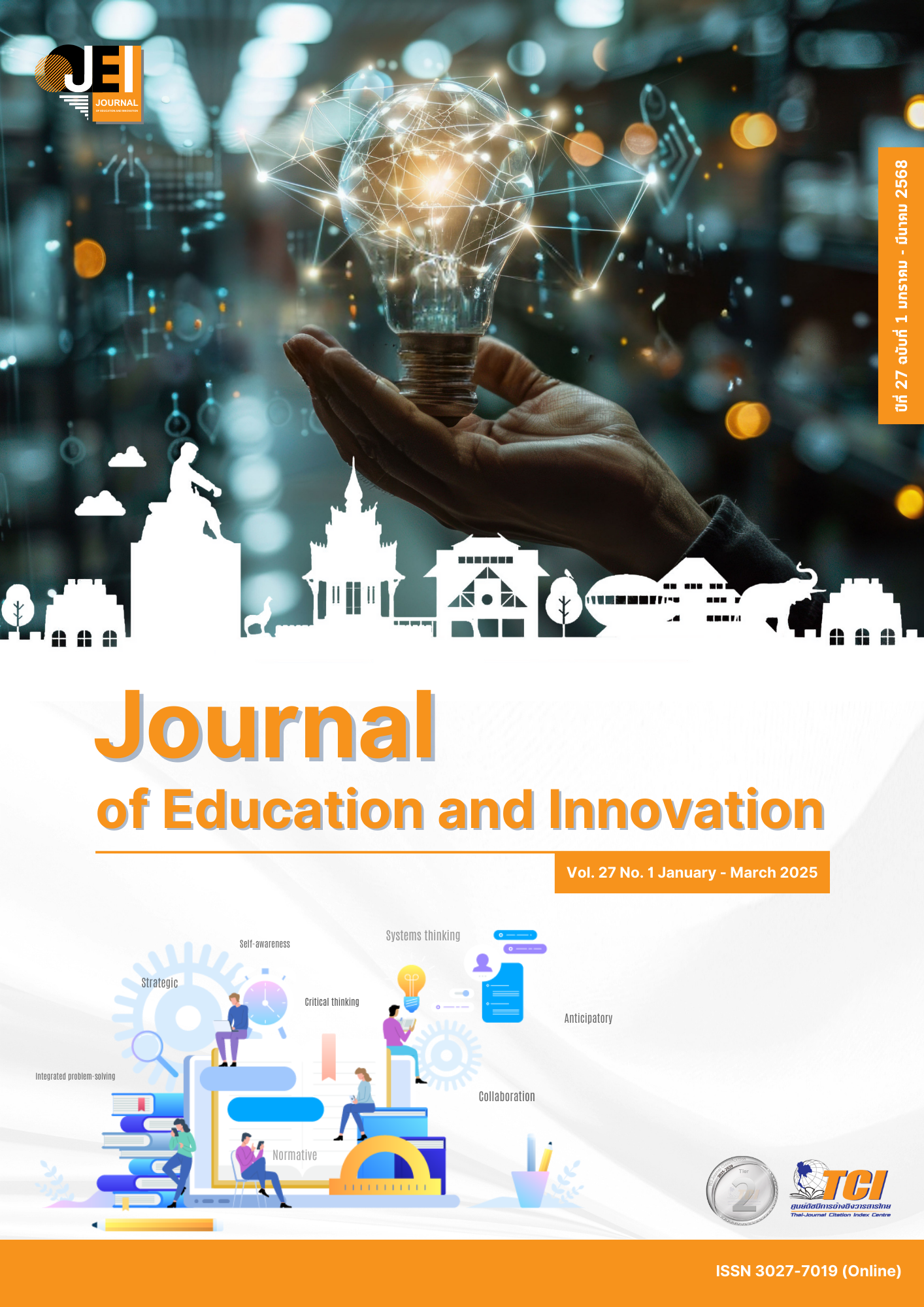THE ADMINISTRATION OF EDUCATIONAL OPPORTUNITY EXPANSION SCHOOLS THAT PROMOTES CHARACTERISTICS OF HIGH FUNCTIONING CLASSROOM
Main Article Content
Abstract
This article aimed 1) to study the characteristics of high functioning classroom in educational opportunity expansion schools; 2) to examine the administrative conditions of educational opportunity expansion schools that promote characteristics of high functioning classroom; and 3) to present the administration of educational opportunity expansion schools that promotes characteristics of high functioning classroom. This research is a qualitative multi-case study. The key informants were 36 people, including school administrators, teachers, and students from 3 educational opportunity expansion schools. The research tools used were semi-structured interviews and documentary research. The data were analyzed using content analysis from field notes through transcription and analytic induction. The study’s findings were: 1) The characteristics of high functioning classroom have 12 components divided into 3 areas, which were overall rated at a moderate to high level. The roles/behaviors and relationships were at the highest level, while learning space and time management for learning were at the lowest level. 2) The administrative conditions of all 3 case studies had similar approaches but varied implementation methods based on their specific contexts. These focused on teacher development, environment arrangement, and promoting active learning. 3) The administration that promotes characteristics of high functioning classroom consists of 3 areas: 1) Roles/behaviors and relationships were at a high level, using principles of understanding, accessing, and developing, promoting professional learning communities, and supporting instructional media and materials; 2) Learning space and time management were at a low level, with four-department administrative structure and learning environment arrangement; and 3) Learning process management was at a moderate level, promoting active learning and learning innovation development. This research provides findings that can be used as guidelines to promote and develop characteristics of high functioning classroom in public educational institutions, ensuring students receive quality education and grow into responsible citizens.
Article Details

This work is licensed under a Creative Commons Attribution-NonCommercial-NoDerivatives 4.0 International License.
The owner of the article does not copy or violate any of its copyright. If any copyright infringement occurs or prosecution, in any case, the Editorial Board is not involved in all the rights to the owner of the article to be performed.
References
Baker, B. D. (2017). How money matters for schools. Palo Alto: Learning Policy Institute.
Bonwell, C. C., & Eison, J. A. (1991). Active Learning: Creating Excitement in the Classroom. ASHE-ERIC Higher Education Reports. ERIC Clearinghouse on Higher Education, The George Washington University.
Chantawanich, S. (2018). Qualitative research methods (24th ed.). Bangkok: Chulalongkorn University Press.
Creativity, Culture and Education. (2012). Changing Young Lives. Retrieved from
http://www.creativitycultureeducation.org/wp-content/uploads/Changing-Young-Lives-2012.pdf
Darling-Hammond, L., Hyler, M. E., & Gardner, M. (2017). Effective teacher professional development. Palo Alto: Learning Policy Institute.
Fleming, N. D. (2001). Teaching and learning styles: VARK strategies. Christchurch, New Zealand: N.D. Fleming.
Foundation for Future Skills. (2021). Report on the Implementation of the Systemic Quality Enhancement Project for Small Schools through Innovation Learning and Management Hub Schools. Retrieved from https://research.eef.or.th/research/upgrading-the-quality-of-the-school/
Fullan, M. (2007). The new meaning of educational change (4th ed.). New York: Teachers College Press.
Guskey, T. R. (2002). Professional development and teacher change. Teachers and Teaching, 8(3), 381-391.
Hanushek, E. A. (2020). Education production functions. In The Economics of Education (pp. 161-170). Academic Press.
Hattie, J. (2012). Visible learning for teachers: Maximizing impact on learning. London: Routledge.
Ingersoll, R. M. (2001). The realities of out-of-field teaching. Educational Leadership, 58(8), 42-45.
Jareonsettasin, T. (2018). Thailand 4.0 Education in the Context of Education for Sustainable Development. Journal of Education Naresuan University, 20(4), 1-14.
Khemmanei. T. (2015). The Art of Teaching: Knowledge for Effective Learning Process Management (19th ed.). Bangkok: Chulalongkorn University Press.
Kolb, D. A. (2014). Experiential learning: Experience as the source of learning and development. New Jersey: FT Press.
Leithwood, K., Harris, A., & Hopkins, D. (2020). Seven strong claims about successful school leadership revisited. School Leadership & Management, 40(1), 5-22.
Marzano, R. J. (2017). The New Art and Science of Teaching. Bloomington, IN: Solution Tree Press.
Moser, A., & Korstjens, I. (2018). Practical guidance to qualitative research: Sampling, data collection and analysis. European Journal of General Practice, 24(1), 9-18.
Neill, S., & Etheridge, R. (2008). Flexible learning spaces: The integration of pedagogy, physical design, and instructional technology. Marketing Education Review, 18(1), 47-53.
Office of the Basic Education Commission. (2019). Handbook for school administration in the legal entity-based development project. Bangkok: Cooperative of Agricultural Printing of Thailand.
Office of the Basic Education Commission. (2020). Guidelines for the operation of educational opportunity expansion schools. Bangkok: Ministry of Education.
Office of the Education Council. (2017). National Education Plan 2017-2036. Bangkok: Prikwarn Graphic.
Panich, V., Susilavorn, S., & Vittayaporn, N. (2023). For Teachers and Students to Become Self-Developers. Bangkok: Siam Commercial Foundation.
Partnership for 21st Century Learning. (2019). Framework for 21st Century Learning. Retrieved from http://www.battelleforkids.org/networks/p21/frameworks-resources
Phothisita, C. (2016). The science and art of qualitative research (7th ed.). Nakhon Pathom: Institute for Population and Social Research, Mahidol University.
Premsuk, S., Kornpuang, A., BuoSonte, R., & Prachanban, P. (2023). The Best Practice in Administration of Secondary School Student Care-Taking System: Multiple Case Study Research. Journal of Multidisciplinary in Humanities and Social Sciences, 6(4), 1855–1872.
Premsuk, S., Kornpuang, A., Buosonte, R., & Prachanban, P. (2024). A development of strategic management model of student care-taking system to enhance the quality of secondary school students. Journal of Education and Innovation, 26(1), 303–320.
Runcharoen, T. (2017). School administration in the era of educational reform (5th ed.). Bangkok: Khaofang.
Sararatana, W. (2013). Educational Administration: Principles, Theories, Functions, Issues, and Analysis. Bangkok: Thippayawisut.
Tomlinson, C. A. (2014). The differentiated classroom: Responding to the needs of all learners. Alexandria, VA: ASCD.
Tomlinson, C. A., & Imbeau, M. B. (2010). Leading and managing a differentiated classroom. Alexandria, VA: ASCD.
UNESCO. (2015). Education 2030: Incheon Declaration and Framework for Action for the implementation of Sustainable Development Goal 4. Paris: UNESCO.
Vygotsky, L. S. (1978). Mind in society: The development of higher psychological processes. Cambridge: Harvard University Press.

